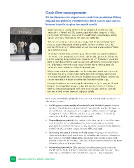Cambridge IGCSE® Business Studies support
With extensive experience as a business focused economist and as an educator, Brian Titley is an expert in helping students to understand complex business issues and ideas. Here, he shares practical tips and case studies for teaching students about making losses and its implications…
Cambridge IGCSE and O level students may develop and hold the view that a loss making business is a failing business and will ultimately face closure. These beliefs may be reinforced by news reports focused on business failures at the local, national and international level – especially as many economies continue to struggle with suppressed levels of demand, investment and confidence following the financial crisis of 2008.
But will a loss making business always face closure? Getting students thinking about business dynamics will encourage them to consider other possibilities. This will help to challenge any misconceptions that a loss making business will always fail, and will enrich your students’ understanding of business organisation, decision making and performance and the multiple factors that impact on these.
Encourage students to think critically about business dynamics
Of course, many businesses do make losses immediately after start-up or major restructurings. But these may be temporary, if businesses have an objective to achieve long run profit maximisation through growth in scale and market share. Formerly profitable businesses may also face losses during a major economic downturn. Those with strong balance sheets, business models and management are able to survive and return to profit as conditions improve while others may be saved by a change of management, a change of product lines and/or a refinancing package. Inevitably those with the weakest business models, products and an inability to adapt to changing market conditions will fail.
To help your students to think about different contributing factors and to broaden their understanding of Business, ask them to consider the following questions about loss-making businesses:
- Are the factors that have resulted in a loss internal or external to the business?
- Are the factors that have resulted in a loss temporary or permanent?
- Is the business objective short run or long run profit maximisation?
- Is the market expanding or contracting?
- Is the business a single product or multi-product firm and which product lines are loss making?
Make it relevant – apply these questions to real-life case studies
For example, the questions above can be applied to this case study on British Airways, from Complete Business Studies for Cambridge IGCSE and O Level. The case study considers the losses at British Airways following the decrease in passenger numbers, during the global economic downturn from 2008. The company’s attempts to cut workforce costs resulted in strike action that threatened to deepen those losses, and the activity involves a role play to settle the dispute. The exercise can be extended through application of the above questions, and by using updates on business performance from online news media and company reports. This should help students to arrive at this solution:
- Are the factors that have resulted in a loss internal or external to the business? Temporary or permanent? The losses were clearly caused by a combination of temporary external and internal factors. Despite the turbulence BA has since returned to growth in passenger numbers, revenues and profit.
- Is the business objective short run or long run profit maximisation? The actions taken by BA suggests its key business objectives are survival and long term profit maximisation.
- Is the business a single product or multi-product firm and which product lines are loss making? It is a multi-product firm. Although its core business is airline operation it serves many different international markets and transports freight as well as passengers. Cutting out unprofitable routes would help the business increase its overall profitability.
Activity – make connections to other Business Studies topics
Applying of the same four questions to contrasting case studies can also be used to introduce, revise, and make connections between other key elements of Business Studies. For example, ask students to contrast this case study about the failure of Escada with the successful business model of the Spanish clothing designer, manufacturer and retailer Zara. This will encourage them to consider connections between profitability, the marketing mix, the management of cash flow and access to finance.Brian Titley is an economist with significant, senior level experience of working with organisations in both the public and private sector. He is author of Complete Business Studies for Cambridge IGCSE and O Level, as well as the bestselling Complete Commerce series.
Download Brian's sample case studies
-
IGCSE® is the registered trademark of Cambridge International Education.
© 2024 Oxford University Press. All rights reserved.


 Show all resources in Cambridge IGCSE® Business Studies support
Show all resources in Cambridge IGCSE® Business Studies support


